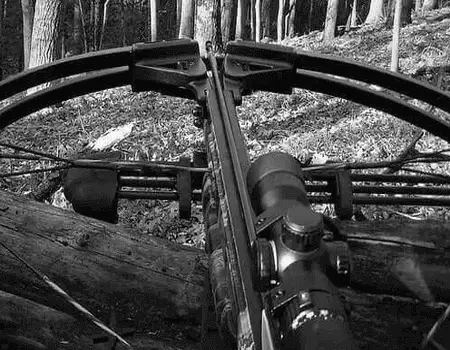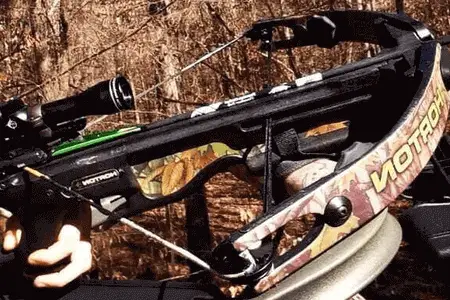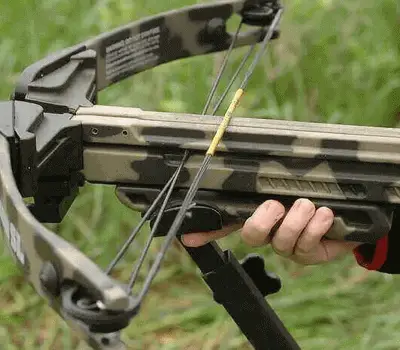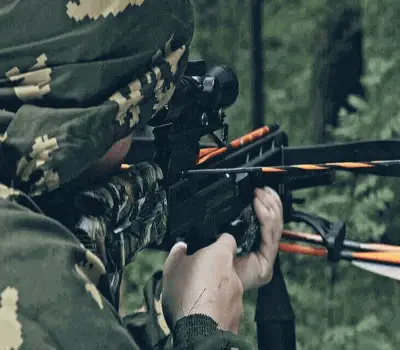Disclosure: We may earn commissions if you purchase products after clicking on a link from our site.
A crossbow is a powerful hunting tool, but it’s important to keep it in good condition if you want it to last. In this blog post, we will discuss some tips and tricks for how to maintain your crossbow. We’ll cover everything from cleaning to storage to repairs. If you follow these guidelines, your crossbow will stay in good shape for years to come!

Table of Contents
- 1 How To Maintain Your Crossbow
- 1.1 1. Inspecting The Bow
- 1.2 2. Inspecting The Crossbow
- 1.3 3. Tuning The Bowstring
- 1.4 4. Oiling The Crossbow
- 1.5 5. Arrow Maintenance
- 1.6 6. Never Dry Fire Your Crossbow
- 1.7 7. Store Your Arrows
- 1.8 8. Crossbow Storage
- 1.9 9. Check Bolts & Screws
- 1.10 10. Clean The Scope Lens
- 1.11 11. Inspect The Cocking Mechanism
- 1.12 12. Check Arrows For Straightness
- 2 Types of Crossbows
- 3 The Bottom Line
How To Maintain Your Crossbow
1. Inspecting The Bow
Inspecting the bowstring is an important part of maintaining your crossbow. This involves checking it for fraying, wear, and tear. If there is any damage, the string has to be replaced.
Inspecting the bowstring is a crucial step in maintaining a crossbow’s performance and safety. Hunters should regularly examine the bowstring for signs of wear, fraying, or damage, as these can compromise accuracy and pose safety risks.
Starting at the serving near the cams, hunters should run their fingers along the entire length of the string, feeling for any rough spots or abnormalities. They should pay particular attention to areas where the string contacts the cams or pulleys, as these are common points of wear. Any signs of fraying or damage should be addressed immediately by replacing the string or serving.
Additionally, hunters should check the string’s alignment with the rail and ensure that it is properly seated in the string track to prevent misfires or inconsistent performance. By regularly inspecting and maintaining the bowstring, hunters can ensure that their crossbows perform reliably and accurately during hunting expeditions.
2. Inspecting The Crossbow
Regularly inspect the crossbow for any damage or wear and tear. Inspect it carefully for any cracks in the stocks or limbs. Make sure all the screws are always tight.
Inspecting the crossbow is a crucial step in maintaining its performance and safety. This process involves carefully examining each component of the crossbow to ensure that it is in proper working condition. Hunters should start by inspecting the limbs for any signs of damage, such as cracks or splinters, which could affect the crossbow’s integrity and accuracy.
Next, they should check the string and cables for wear and tear, looking for fraying or signs of stretching that could indicate the need for replacement. It’s also important to inspect the trigger mechanism and safety features to ensure they are functioning correctly and reliably.
Additionally, hunters should examine the stock and rail for any signs of damage or loose screws that could affect the crossbow’s stability and accuracy. By regularly inspecting their crossbows, hunters can identify and address any issues before they compromise performance or safety, ensuring a successful and enjoyable hunting experience.
3. Tuning The Bowstring
Regularly check the crossbow’s string for any signs of wear and tear. If the string is frayed or broken, it has to be replaced. It is good practice to check the string before each shooting session. After every 20 to 30 shots, wax the string.
Additionally, inspect the cams and wheels for wear and tear. Every hunting season, it is good practice to replace the strings and cables. We did an article on the 30 hunting items every hunter needs and you can read it from this link.
Tuning the bowstring is an essential step in maintaining a crossbow’s accuracy and reliability. To tune the bowstring, hunters should ensure that it is properly aligned with the center of the rail and that it sits evenly in the string track. This alignment helps to prevent string wear and ensures consistent arrow flight. Hunters can use a string alignment tool or simply visually inspect the string’s position relative to the rail.
Additionally, ensuring that the string is correctly seated in the string track helps to prevent misfires and inconsistencies in arrow trajectory. Hunters should also check the brace height, which is the distance between the string and the bow’s grip, to ensure it falls within the manufacturer’s specifications.
Making adjustments to the brace height can fine-tune the bow’s performance and optimize arrow flight. By regularly tuning the bowstring and checking the brace height, hunters can maintain their crossbows in peak condition for hunting expeditions.
4. Oiling The Crossbow
To prevent corrosion, you need to regularly oil the crossbow. Lubricate the crossbow moving parts, including the trigger mechanism and the string, with light oil. If there is any excess oil, wipe it with a clean cloth.
Oiling the crossbow is a crucial step in its maintenance routine to ensure smooth operation and longevity. Hunters should apply a thin layer of lubricant to key components such as the rail, trigger mechanism, and cams to reduce friction and prevent corrosion.
Using a specialized crossbow rail lube or silicone-based lubricant, hunters can protect against wear and tear caused by repeated use and exposure to the elements. It’s essential to follow the manufacturer’s recommendations for lubrication intervals and avoid over-oiling, as excess lubricant can attract dirt and debris, leading to potential malfunctions. By regularly oiling the crossbow, hunters can maintain its performance and reliability, ensuring a successful and enjoyable hunting experience.

5. Arrow Maintenance
Regularly inspect the arrows for any sign of damage or wear and tear. Look for cracks or chips in the shaft. If you find any, replace them. Wipe the arrows down with a soft cloth after each use to keep them clean and free of debris. Inspect the tips of the arrows for sharpness and keep them sharp by getting a professional’s help or sharpen them yourself.
Dull tips can result in the crossbow losing accuracy. A can of compressed air can also be used to remove dirt and debris after a hunting day.
Arrow maintenance is paramount for ensuring optimal performance and accuracy when using a crossbow. Hunters should regularly inspect their arrows for any signs of damage, such as cracks, bends, or loose fletchings, and replace them as needed to prevent misfires or inconsistent shots.
Additionally, it’s essential to check the arrow tips for sharpness and tighten any loose inserts to maintain proper arrow flight. Keeping arrows clean and free of dirt or debris helps preserve their integrity and prolongs their lifespan. Proper storage in a quiver or arrow case also protects them from damage during transport or while in storage. By maintaining arrows in top condition, hunters can maximize their shooting accuracy and increase their chances of a successful hunt.
6. Never Dry Fire Your Crossbow
Never shoot your crossbow without an arrow. This can damage the crossbow. One crucial step in maintaining a crossbow is to never dry fire it, as doing so can cause significant damage to the bow’s components.
Dry firing occurs when the trigger is pulled without an arrow loaded, causing the string to snap forward with nothing to absorb the energy. This sudden release of energy can lead to stress on the limbs, cams, strings, and other parts of the crossbow, potentially causing them to break or malfunction. To prevent dry firing, hunters should always ensure that an arrow is properly seated on the rail before pulling the trigger.
Additionally, it’s essential to follow proper cocking and firing procedures outlined in the crossbow’s manual to minimize the risk of accidents and maintain the bow’s longevity. Regularly inspecting the crossbow for any signs of wear or damage and addressing issues promptly can help ensure safe and effective use during hunting activities.
7. Store Your Arrows
Properly store your arrows in a quiver or crossbow case when they are not been used to keep them in good condition. The review on the best crossbow cases can be found at this link.
Properly storing your arrows is an essential step in maintaining your crossbow and ensuring their performance and longevity. To store your arrows effectively, it’s crucial to keep them in a dry and cool environment away from direct sunlight and extreme temperatures, as exposure to moisture, heat, or cold can damage the shafts and affect their structural integrity.
Additionally, storing arrows vertically in a sturdy arrow rack or case can help prevent warping or bending of the shafts. It’s also advisable to store arrows with their fletchings facing upward to prevent them from becoming deformed or flattened.
Regularly inspecting stored arrows for any signs of damage, such as cracks, splits, or loose fletchings, and replacing any compromised arrows can help maintain the quality and safety of your equipment. By following these storage practices, hunters can ensure that their arrows remain in optimal condition for accurate and reliable performance during hunting expeditions.
8. Crossbow Storage
Put the crossbow in a crossbow case and store it in a cool and dry location. Proper storage of your crossbow is vital for maintaining its performance and prolonging its lifespan. When not in use, store your crossbow in a dry, cool, and secure location to protect it from moisture, extreme temperatures, and potential damage.
It’s recommended to place the crossbow in a padded case or a specially designed crossbow storage rack to prevent it from shifting or getting scratched. Ensure that the string is uncocked and the safety mechanism engaged before storing to relieve tension and prevent premature wear.
Additionally, storing the crossbow vertically or horizontally, depending on available space, can help maintain its alignment and integrity. Regularly inspect the stored crossbow for any signs of damage or deterioration, such as loose components or rust, and address any issues promptly to ensure it remains in optimal condition for future use. By following these storage practices, hunters can preserve the functionality and reliability of their crossbows for many hunting seasons to come.

9. Check Bolts & Screws
Regularly check the bolts and screws of the crossbow for tightness. If you hunt regularly during the hunting season, then you want to check the bolts and screws every few weeks. If you hunt monthly or sporadically, then checking the screws and bolts once a month will work.
Regularly inspecting bolts and screws is a crucial step in maintaining your crossbow’s performance and safety. Before each use, carefully examine all bolts and screws on your crossbow to ensure they are securely tightened.
Loose bolts or screws can lead to misalignment, affecting accuracy and potentially causing malfunctions. Use the appropriate tools, such as screwdrivers or Allen wrenches, to tighten any loose fasteners gently. Pay close attention to critical areas, including the stock, limbs, riser, and scope mounts.
Additionally, inspect for signs of wear or damage, such as stripped threads or rust, and replace any compromised bolts or screws promptly. By keeping all fasteners properly tightened and in good condition, you can maintain the structural integrity of your crossbow and minimize the risk of accidents or equipment failure while in use.
10. Clean The Scope Lens
When you notice your vision is cloudy due to fingerprints or other material coming into contact with the lens, you should clean the lens and lens cover. It is best to use lens-cleaning wipes.
Cleaning the scope lens is an essential step in maintaining your crossbow’s accuracy and performance. Over time, dirt, dust, and debris can accumulate on the lens, obscuring your field of view and affecting the clarity of your aim.
To clean the scope lens effectively, start by using a soft-bristled brush or compressed air to remove any loose particles. Then, dampen a microfiber cloth with a small amount of lens cleaning solution or isopropyl alcohol and gently wipe the lens in a circular motion, starting from the center and working your way outwards.
Avoid using abrasive materials or excessive pressure, as this can scratch or damage the lens coating. Once the lens is clean, use a dry microfiber cloth to remove any remaining moisture or streaks, ensuring a clear and unobstructed view through your scope. Regularly cleaning the scope lens will help maintain optimal visibility and ensure accurate shooting while using your crossbow.
11. Inspect The Cocking Mechanism
Inspect the cocking mechanism for any wear and tear. If any part is damaged, it has to be replaced. Additionally, check for any bolts, nuts, and screws that need to be tightened. Lubricate the cocking mechanism.
Inspecting the cocking mechanism is a crucial step in maintaining your crossbow’s functionality and safety. The cocking mechanism plays a vital role in properly tensioning the bowstring and preparing the crossbow for firing.
Begin by visually inspecting the cocking device for any signs of wear, damage, or misalignment. Check the string hooks or claws for any signs of fraying or deformation, as these can affect the crossbow’s performance and pose a safety risk.
Ensure that all components of the cocking mechanism are securely attached and functioning correctly. Test the cocking device by cocking and decocking the crossbow several times, paying attention to any unusual sounds or resistance.
If you notice any issues or abnormalities during the inspection, it is essential to address them promptly to prevent malfunctions or accidents while using your crossbow. Regularly inspecting the cocking mechanism will help ensure reliable operation and safe shooting with your crossbow.
12. Check Arrows For Straightness
Spin the arrows with field points to test for straightness. Check for bent ferrules, inserts, or shafts. If there is any wobbling, find out which part of the arrow is the culprit. Sometimes the likelihood is that the arrow’s shaft is straight but the ferrule on the field point is bent. The field point can be replaced without discarding the arrow.
Checking arrows for straightness is a vital step in maintaining your crossbow’s accuracy and safety. Begin by visually inspecting each arrow shaft for any signs of bends, cracks, or other damage. Use a straightening tool or arrow spinner to rotate the arrow slowly and identify any wobbling or irregularities in its flight path. Gently roll the arrow on a flat surface to detect any deviations from straightness.
Next, use a straightness gauge to measure the arrow’s straightness tolerance along its entire length. Discard any arrows that do not meet the required straightness specifications to ensure consistent and precise shooting with your crossbow. Regularly checking and replacing arrows as needed will help optimize your crossbow’s performance and minimize the risk of accidents or malfunctions during shooting.

Types of Crossbows
1. Recurve Crossbow
Recurve crossbows are the traditional crossbows with few parts. It is ideal for hunting small game as it is lightweight and requires low maintenance. Recurve crossbows are a traditional and time-tested type of crossbow characterized by their distinct limb design, which curves away from the shooter at the tips. This design allows for greater power and speed compared to straight-limbed crossbows of similar draw weights.
Recurve crossbows are known for their simplicity, reliability, and ease of maintenance. They typically produce less noise and vibration upon firing, making them popular among hunters and target shooters alike. Due to their shorter power stroke, recurve crossbows may require more physical effort to cock compared to compound crossbows. However, their straightforward design and durability make them a favorite choice for those who appreciate the classic appeal and performance of traditional archery equipment.
2. Compound Crossbow
The compound crossbow is the newer crossbow with technological advancements. it features many parts and is heavier than the recurve crossbow. It is best suited for hunting larger game and is ideal for beginners. It is a high-maintenance crossbow.
Compound crossbows are modern, technologically advanced variations of traditional crossbows, featuring a system of cams and cables that generate increased power and speed. The unique design of compound crossbows allows for a longer power stroke, resulting in greater arrow velocity and improved accuracy over longer distances compared to recurve crossbows. These crossbows often feature a more compact and ergonomic design, making them easier to handle and maneuver in tight hunting situations.
Additionally, compound crossbows typically come equipped with a variety of accessories, such as adjustable sights, integrated cocking mechanisms, and noise-dampening features, enhancing their overall performance and user experience. While compound crossbows may require more maintenance due to their complex mechanisms, their superior power, accuracy, and versatility have made them a popular choice among hunters and target shooters seeking top-of-the-line performance.

The Bottom Line
Maintaining your crossbow is very important for the crossbow to perform at a peak level. In this article, we discussed how to maintain your crossbow to help you keep it in the best condition. Hunting with crossbows is another effective way of hunting and some hunters prefer using crossbows over other weapons.
It requires a different set of skills that you can master over a period of time. You can improve your skills by getting some tips from this article on how to hunt deer with a crossbow.